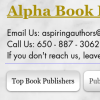-
About
- About Listly
- Community & Support
- Howto
- Chrome Extension
- Bookmarklet
- WordPress Plugin
- Listly Premium
- Privacy
- Terms
- DMCA Copyright
- © 2010-2025 Boomy Labs

 Alpha Book Publisher
Alpha Book Publisher
Listly by Alpha Book Publisher
Discover the profound impact of typography on your reading adventure. Explore how the artful arrangement of letters, fonts, and spacing can elevate the way you absorb information, immersing you in a captivating narrative or guiding your focus through complex texts. Uncover the secrets behind typographic choices that enhance comprehension, evoke emotions, and streamline the reading process. From subtle nuances to bold design decisions, delve into the realm where typography meets storytelling and unlock new dimensions in your reading experience. Learn more: http://typographic.publishingdot.store/TypographicPublishingDot.html
Source: http://coverstory.publishingdot.store/CoverStoryPublishingDot.html
Typography refers to the art and technique of arranging type to make written language readable and appealing. It encompasses various elements such as font selection, font size, spacing, alignment, and overall layout. Each of these elements contributes to the overall visual presentation and readability of text.
Choosing the right font and font size is essential for ensuring readability. Fonts vary in style and personality, with some being more suitable for long-form reading than others. For instance, serif fonts like Times New Roman are often preferred for printed materials due to their readability in longer passages, while sans-serif fonts like Arial are favored for digital content for their clean and modern look.
Typography helps establish hierarchy within a text, guiding readers through the content by signaling what information is most important. Headings and subheadings are typically set in larger, bolder fonts to stand out and indicate key sections of the text. This hierarchy helps readers navigate the material more efficiently and grasp the main points quickly.
The choice of typography also contributes to setting the tone and mood of the text. Different fonts evoke different emotions and associations. For example, a sleek and modern font may convey professionalism and sophistication, while a playful and whimsical font may suggest a more casual or lighthearted tone. By selecting fonts that align with the content's intended tone, publishers can enhance the overall reading experience and reinforce the message they wish to convey.
In addition to aesthetics, typography also plays a crucial role in ensuring accessibility for all readers, including those with visual impairments. Factors such as font size, line spacing, and contrast are essential considerations for making text legible to individuals with varying visual abilities. Publishers can enhance accessibility by choosing fonts that are easy to read and optimizing layout and formatting for clarity and comprehension.
Stay updated on the latest developments in typography, from innovative font designs to emerging layout techniques. Discover how contemporary trends shape the way we perceive and interact with written content.
Unlock the secrets to harmoniously combining different typefaces for maximum visual impact. Learn the art of pairing serif with sans-serif, script with display fonts, and other strategies to create compelling typographic compositions.
Dive into the realm of web typography and uncover best practices for optimizing text readability across various digital platforms. Explore techniques such as responsive typography and variable fonts to ensure a seamless reading experience on any device.
Explore how typography influences brand identity and consumer perception. Delve into case studies and expert insights to understand how font choices can evoke brand personality, establish credibility, and foster brand recognition.
Discover the role of typography in multimodal communication, where text interacts with other visual and auditory elements. Explore how typography integrates with images, videos, and interactive media to convey meaning and engage audiences across diverse channels.
